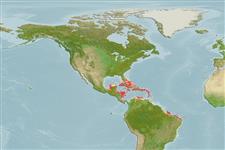Environment: milieu / climate zone / depth range / distribution range
البيئة
بحري مرتبطة بالشعاب. Tropical
Western Atlantic: Bahamas to Curaçao.
الحجم / وزن / العمر
Maturity: Lm ? range ? - ? cm
Max length : 3.8 cm TL ذكر/ مختلط الجنس; (Ref. 5521)
وصف مختصر
الوصف الخارجي | قياسات المظهر الخارجي
الأشعة الظهرية الناعمة (المجموع): 7-37; شوكة شرجية 2. Common amongst Labrisomids: small, often elongate fishes; largest species about 20 cm standard length, most under 10 cm standard length. Head usually with cirri or fleshy flaps on anterior nostrils, eyes, and laterally on nape; gill membranes continuous with each other across posteroventral surface of head. Each jaw with an outer row of relatively large, canine-like or incisor-like teeth, often with patches of smaller teeth behind; teeth usually also present on vomer. Dorsal and anal fins long, frequently highest anteriorly; dorsal-fin spines often flexible, outnumbering segmented dorsal-fin soft rays; 2 usually flexible spines in anal fin; pelvic fins inserted anterior to pectoral-fin bases, with 1 spine not visible externally; all fin rays, including those of caudal, unbranched (simple). Cycloid (smooth to touch) scales present at least posteriorly on body. Body coloration: varying from drab to brilliant hues; usually with irregular vertical bands, spots, or marbled pattern. Species distinguished by: dorsal fin consisting of spines and 7 to 37 segmented rays; cirri on anterior nostril and bove eye usually 2; two or more cirri on each side of nape just anterior to dorsal-fin origin; pectoral-fin rays usually 16; length of shortest pelvic-fin ray (third ray very difficult to see) contained fewer than 4 times in length of longest ray; pelvic-fin soft rays 3 (innermost ray may be reduced in length and folded over middle ray); scales in lateral-line series 40 to 69 (some scales in posterior portion of lateral line may lack sensory tubes, but are included in count); pectoral-fin base naked; maxillary bone sheathed; small teeth present behind large teeth in outer row (small teeth inconspicuous and easily knocked out while probing); teeth absent on palatines; distinct, dark blotch at bases of posteriormost dorsal-fin spines (Ref.52855).
Inhabits surfaces of rocks, in depressions, and among clumps of algae, among broken coral debris and rocks in only a few feet of water (Ref. 5521).
Life cycle and mating behavior
النضج | التكاثر | وضع البيض | بيض | الخصوبة | Larvae
Böhlke, J.E. and C.C.G. Chaplin, 1993. Fishes of the Bahamas and adjacent tropical waters. 2nd edition. University of Texas Press, Austin. (Ref. 5521)
IUCN Red List Status (Ref. 130435)
استخدامات بشرية
مزيد من المعلومات
الأسماء الشائعةمرادفاتالأيضمفتريساتعلم السميات البيئيةالتكاثرالنضجوضع البيضتجمعات وضع البيضالخصوبةبيضتطور البيضة
العمر/ الحجمنموالطول-الوزنالطول-الطولالطول- التردداتقياسات المظهر الخارجيالوصف الخارجيLarvaeحركة انتقال اليرقاتتوظيفالوفرةBRUVS
مراجعالأستزراع المائيملف الأستزراع المائيسلالاتجينيElectrophoresesالتوريثالأمراضمعالجةNutrientsMass conversion
المتعاونينصورStamps, Coins Misc.اصواتالتسمم باكل السمكسرعةنوع السباحةمنطقة الخياشيمعظمة الأذندماغرؤية
أدوات
تقارير خاصة
Download XML
مصادر علي الأنترنت
Estimates based on models
Preferred temperature (Ref.
123201): 26.5 - 28.2, mean 27.5 °C (based on 549 cells).
Phylogenetic diversity index (Ref.
82804): PD
50 = 0.5000 [Uniqueness, from 0.5 = low to 2.0 = high].
Bayesian length-weight: a=0.00490 (0.00196 - 0.01224), b=3.09 (2.87 - 3.31), in cm total length, based on LWR estimates for this (Sub)family-body shape (Ref.
93245).
مستوى غذائي (Ref.
69278): 3.2 ±0.4 se; based on size and trophs of closest relatives
Fishing Vulnerability (Ref.
59153): Low vulnerability (10 of 100).
Nutrients (Ref.
124155): Calcium = 209 [89, 394] mg/100g; Iron = 0.834 [0.437, 1.543] mg/100g; Protein = 18.1 [16.8, 19.2] %; Omega3 = 0.113 [0.054, 0.225] g/100g; Selenium = 17.5 [6.2, 44.9] μg/100g; VitaminA = 328 [89, 1,219] μg/100g; Zinc = 2.7 [1.6, 4.1] mg/100g (wet weight);
